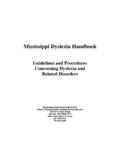Transcription of LINNEA C. EHRI and SIMONE R. NUNES, City …
1 Abstract: A quantitative meta-analysis evalu-ating the effects of systematic phonics instruc-tion compared to unsystematic or no-phonicsinstruction on learning to read was conductedusing 66 treatment control comparisonsderived from 38 experiments. The overalleffect of phonics instruction on reading wasmoderate, d= Effects persisted afterinstruction ended. Effects were larger whenphonics instruction began early (d= )than after first grade (d= ). Phonics ben-efited decoding, word reading, text compre-hension, and spelling in many helped low and middle SES readers,younger students at risk for reading disability(RD), and older students with RD, but it didnot help low achieving readers that includedstudents with cognitive limitations.
2 Syntheticphonics and larger-unit systematic phonicsprograms produced a similar advantage inreading. Delivering instruction to smallgroups and classes was not less effective thantutoring. Systematic phonics instructionhelped children learn to read better than allforms of control group instruction, includingwhole language. In sum, systematic phonicsinstruction proved effective and should beimplemented as part of literacy programs toteach beginning reading as well as to preventand remediate reading 1997, the Congress directed that anational panel be convened to review and eval-uate research on the effectiveness of variousapproaches for teaching children to read.
3 TheDirector of the National Institute of ChildHealth and Human Development (NICHD)in consultation with the Secretary ofEducation constituted the National ReadingPanel (NRP) composed of 14 of the Panel formed subgroups toreview research on alphabetics, comprehen-sion, fluency, teacher education, and technolo-gy. The alphabetics subgroup conducted twometa-analyses, one on phonemic awarenessinstruction (Ehri, Nunes, Willows, Schuster,Yaghoub-Zadeh, & Shanahan, 2001) andanother on systematic phonics of the phonics meta-analysis are pre-sented in this article.
4 The final report incorpo-rating all the subgroup reviews was submittedto Congress in April 2000 (NRP, 2000).Teaching students to read is a complex enter school with substantial compe-tence speaking their language, but typicallythey have little knowledge about how to readand write. The purpose of literacy instructionin schools is to help children master the manychallenges of written language. These includeacquiring knowledge of the alphabetic system,Journal of Direct Instruction121 LINNEA C. EHRI and SIMONE R. NUNES, city University of New York Graduate Center; STEVEN A.
5 STAHL, University of Georgia; DALE M. WILLOWS, Ontario Institute for Studies in Education, University of TorontoSystematic PhonicsInstruction HelpsStudents Learn toRead: Evidence Fromthe National ReadingPanel s Meta-AnalysisJournal of Direct Instruction Vol. 2, No. 2, pp. 121 2001 by the American Educational ResearchAssociation. Reprinted by permission of the of Educational Research, Fall 2001, Vol. 71(3), 393 to decode new words, building avocabulary of words that can be read frommemory by sight, and becoming facile at con-structing, integrating, and remembering mean-ings represented in text.
6 In order for childrento be able to link their knowledge of spokenlanguage to their knowledge of written lan-guage, they must master the alphabetic code,that is, the system of grapheme phoneme cor-respondences that links the spellings of wordsto their pronunciations. Phonics instructionteaches beginning readers the alphabetic codeand how to use this knowledge to read systematic phonics programs, a planned setof phonics elements is taught set includes not only the major correspon-dences between consonant letters and soundsbut also short and long vowel letters andsounds, and vowel and consonant digraphs( , oi, ea, sh, th).
7 It also may include blendsof letter sounds that form larger subunits inwords. The larger units taught might includeonsets (consonants that precede vowels, suchas j in jumpor st in stop) and rimes ( ,the vowel and following consonants such as ump in jumpand op in stop).Over the years, educators have disagreedabout how beginning reading should betaught. Some have advocated starting with asystematic phonics approach whereas othershave argued for whole-word or whole-languageapproaches. Disagreement has centered onwhether teaching should begin with explicitinstruction in symbol sound correspondencesor with whole words, or whether initialinstruction should be meaning-centered withcorrespondences taught incidentally in con-text as needed.
8 The current view is that,because research suggests that systematicphonics approaches are more effective thannonsystematic approaches, children should beprovided with systematic phonics instructionas part of a balanced reading purpose of this review was to examine theresearch evidence to determine whether sys-tematic phonics instruction helps childrenlearn to read more effectively than unsystem-atic phonics instruction or instruction teachinglittle or no phonics. Is phonics instructionmore effective under some circumstances thanothers, such as tutoring versus small groups orclassrooms; beginning grades as opposed tolater grades; for children who are progressingnormally in reading as well as for children whoare at risk or disabled in their reading?
9 Doesphonics instruction improve children s readingcomprehension as well as their word-readingand spelling skills? Does the type of instruc-tion given to control groups to evaluate theeffectiveness of phonics instruction ( ,whole-word or whole-language approaches)make a difference?A meta-analysis was conducted to evaluate theevidence. The Panel searched the literature tolocate experimental studies that administeredsystematic phonics instruction to one group ofchildren and administered another type ofinstruction involving either unsystematicphonics or no phonics to a control group.
10 Thereview was limited to experiments becausethese provide the strongest evidence thatinstruction rather than some other factorcaused the improvement in reading. The stud-ies had to examine phonics programs of thesort used in schools rather than used in labora-tory experiments focused on single studies had to measure reading as an out-come of instruction. Studies were excluded ifthey were in the Panel s other meta-analysisexamining effects of phonemic awarenessinstruction (Ehri et al., 2001). To insure thatthey met the research standards of the field,studies were limited to those published inpeer reviewed journals.

